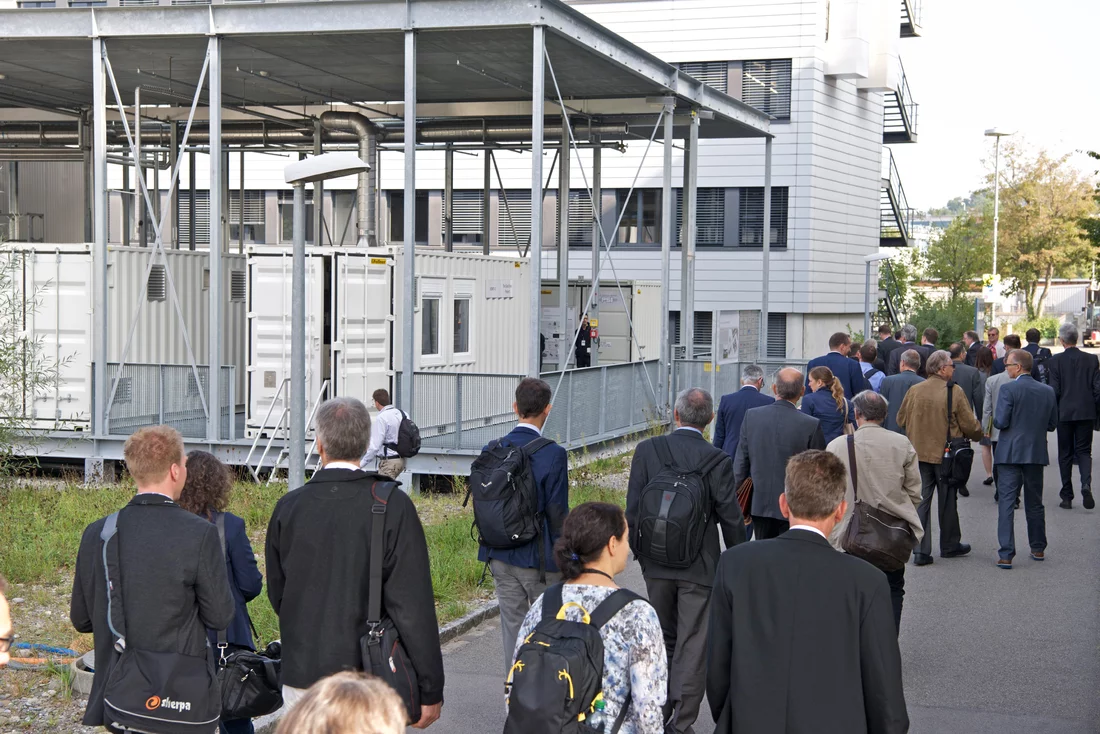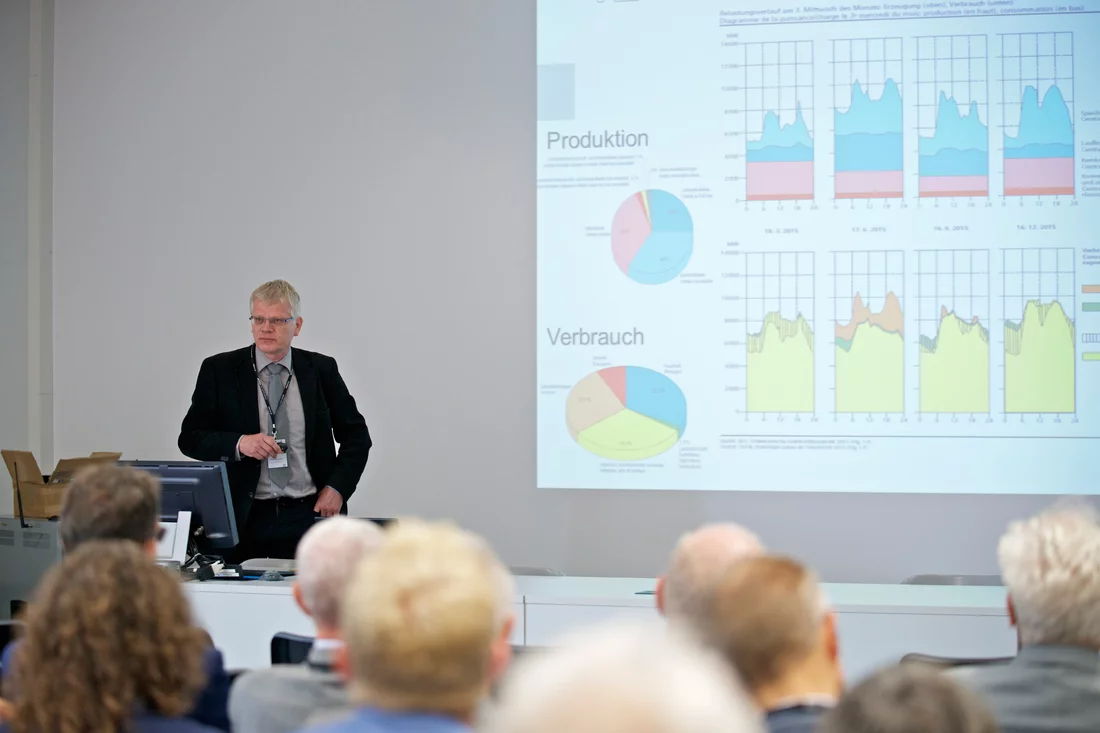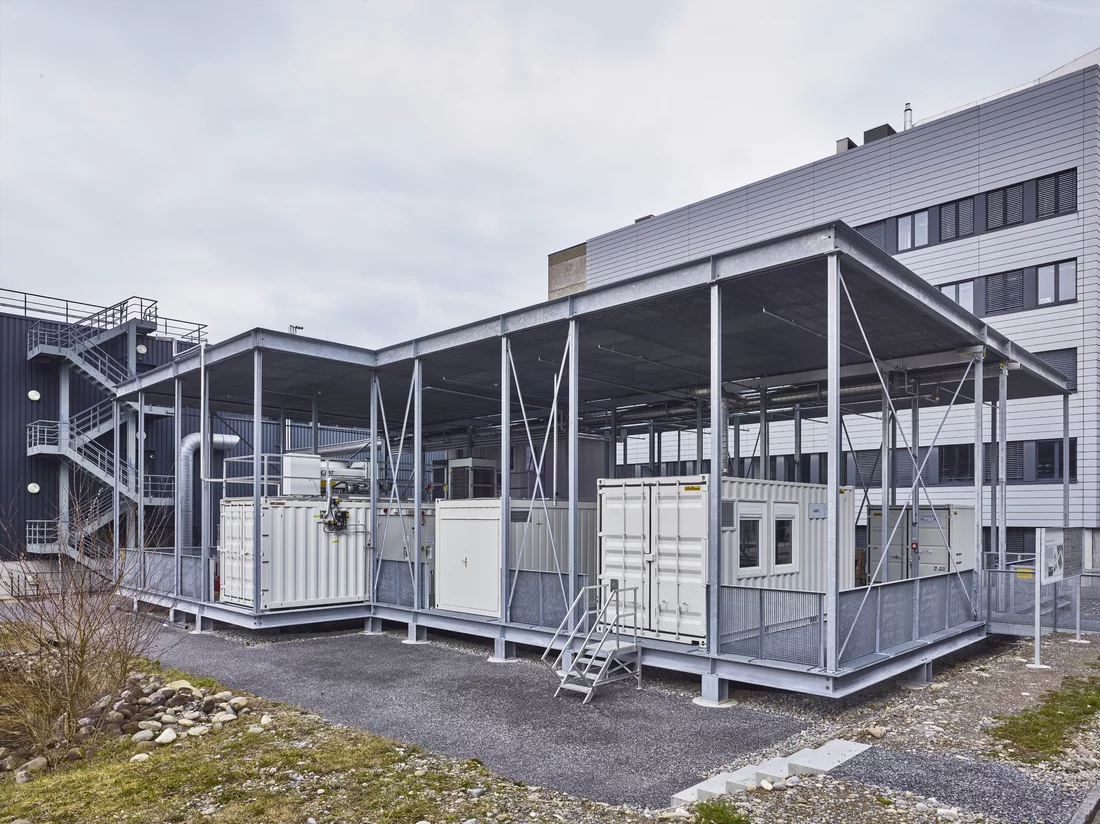This fall, the time has come: The Energy System Integration Platform at the Paul Scherrer Institute PSI goes into operation. Today, in the framework of the double conference Networked Energy Research Switzerland, it was presented to the media and around 150 representatives from politics, industry, and science.
Step by step between now and the year 2050, the Swiss energy system is set to be restructured. The package of measures developed by the federal government under the banner of “Energy Strategy 2050” envisions a strong expansion of new renewable energy sources such as solar and wind power.
Beacon for energy research
The integration of electricity from photovoltaics and wind, however — produced in a decentralised manner and with temporal fluctuations — presents a major challenge to the power networks. With the Energy System Integration or ESI Platform, an experimental platform is coming on line this fall where promising approaches to the conversion and storage of decentralised, renewable energy are brought together. Today the ESI Platform was presented to the media and around 150 representatives from politics, industry, and science within the framework of the joint conference Networked Energy Research Switzerland.
“With the ESI Platform, we at PSI have created a facility with which we can demonstrate how integral storage concepts must look so that a decentralised energy supply can function with renewable energy sources,” says Alexander Wokaun, head of the Energy and Environment Division at the PSI, who opened the conference. “With the ESI Platform, we have raised up a lighthouse that makes key aspects of the Energy Strategy 2050 visible and tangible.”
Close collaboration with research and industry
Close collaboration with partners in research and industry is of great importance. Thus the ESI Platform was realised in coordination with the Swiss Federal Laboratories for Materials Science and Technology (Empa), and ETH Zurich also participates in the cooperation projects. In addition, the ESI Platform should serve as a starting point for initiating new collaborations between PSI and industry within the framework of PARK INNOVAARE. This innovation park is currently taking shape in immediate proximity to the PSI. There, through tight cooperation between the PSI and companies, innovations should be generated and rapidly made ready for the market.
Probing technical feasibility
So-called power-to-gas technology is central to the ESI Platform. It enables energy surpluses that would overload the grids to be used in the production of hydrogen. This can be deployed directly or used for the production of methane. Thus the electric power is converted to energy-rich gases. The advantage of hydrogen or methane is that the gases can be stored for a long time and transported over long distances. On demand, they can be converted back into electric power or heat. The gases can also be used directly as raw materials in industry or as fuel for vehicles.
Individual components of the power-to-gas technology have been the subjects of research at the PSI for many years: “The point of the ESI Platform is for the first time to investigate all of these building blocks, which up to now have been studied in isolation, in all their complex interactions on a pilot scale,” explains Peter Jansohn, head of Energy System Integration at the PSI. With the integration of methane and hydrogen on a common platform, the ESI Platform is breaking new ground: “With this we have the possibility to run through diverse variations of the power-to-gas concept — that differentiates the ESI Platform from other approaches,” Jansohn stresses.
The goal is to probe the limits of what is technically feasible with a 100-kilowatt plant system, as well as to figure out the costs and the options for scaling up to a plant in the megawatt range. The PSI-led competence centres SCCER Heat and Electricity Storage and SCCER BIOSWEET (for bioenergy) will test their newly developed technologies on the ESI Platform. They are two of the energy research competence centres initiated by the federal government within the action plan Coordinated Energy Research Switzerland.
Increasing energy efficiency
By trying out different variants of the power-to-gas concept, researchers can test which variants enable particularly efficient energy use. “Hydrogen as an energy carrier is an essential building block of all power-to-gas plants, because it can be applied flexibly,” stresses Thomas J. Schmidt, head of the SCCER Heat and Electricity Storage. In fuel cell vehicles, on the one hand, it could contribute to decarbonisation of the mobility sector. “On the other hand, as will be demonstrated with the ESI Platform, it can be directly and efficiently converted back to electricity in hydrogen-oxygen fuel cells, creating no waste but water.”
Science Case Coordinator Tilman Schildhauer explains what possibilities are opened up by further processing to methane: “Up to a small amount, hydrogen can be injected into the natural gas network — but through the further conversion of hydrogen to methane, this injection can be done in virtually unlimited quantities.” On the ESI Platform, this so-called methanisation will be investigated, as well as sources for the required carbon dioxide: biogas plants, wood gasifiers, or industrial waste gases. “Especially in the case of biogas plants, methanisation with the addition of hydrogen makes it possible to increase biomethane production by more than one-half,” Schildhauer says.
10-year anniversary of the Competence Center for Energy and Mobility
The second part of the double conference was devoted to the Competence Center for Energy and Mobility CCEM, which was launched in 2006. This research network of the ETH domain promotes technical innovations for a sustainable energy supply and for the strengthening of Switzerland as a business location. Results and their influence on the current energy topics were discussed.
Text: Paul Scherrer Institut/Martina Gröschl
About PSI
The Paul Scherrer Institute PSI develops, builds and operates large, complex research facilities and makes them available to the national and international research community. The institute's own key research priorities are in the fields of matter and materials, energy and environment and human health. PSI is committed to the training of future generations. Therefore about one quarter of our staff are post-docs, post-graduates or apprentices. Altogether PSI employs 2000 people, thus being the largest research institute in Switzerland. The annual budget amounts to approximately CHF 370 million. PSI is part of the ETH Domain, with the other members being the two Swiss Federal Institutes of Technology, ETH Zurich and EPFL Lausanne, as well as Eawag (Swiss Federal Institute of Aquatic Science and Technology), Empa (Swiss Federal Laboratories for Materials Science and Technology) and WSL (Swiss Federal Institute for Forest, Snow and Landscape Research).
(Last updated in May 2016)
Additional information
Overview: ESI Platform – new pathways to the energy system of the futurePartners of the ESI Platform
Contact
Dr Peter JansohnHead of Energy System Integration
Paul Scherrer Institute, 5232 Villigen PSI, Switzerland
Telephone: +41 56 310 28 71, e-mail: peter.jansohn@psi.ch [German, English]



